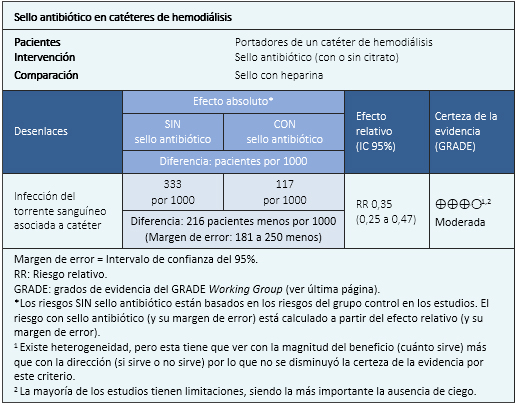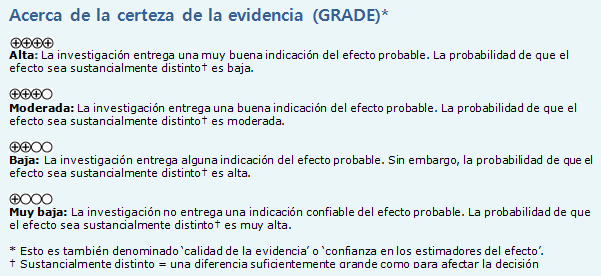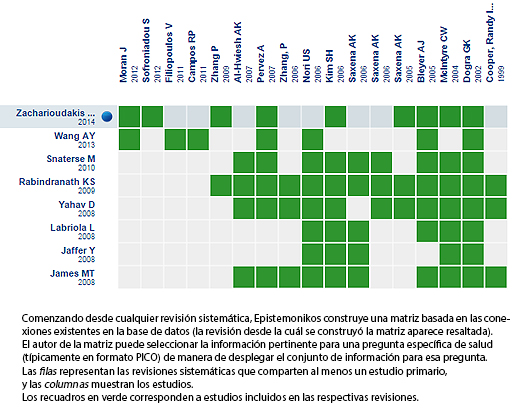 Para Descargar PDF debe Abrir sesión.
Para Descargar PDF debe Abrir sesión.
Las infecciones del torrente sanguíneo asociadas a catéteres venosos centrales son una de las principales complicaciones de su uso, lo cual conlleva a un aumento de morbimortalidad en pacientes con insuficiencia renal en hemodiálisis. El uso de soluciones de sellado con antibióticos podría ser efectivo para prevenir esta complicación. Utilizando la base de datos Epistemonikos, la cual es mantenida mediante búsquedas en más de veinte bases de datos, identificamos ocho revisiones sistemáticas que en conjunto incluyen diecisiete estudios aleatorizados. Realizamos un metanálisis y tablas de resumen de los resultados utilizando el método GRADE. Concluimos que el uso de soluciones de sellado con antibióticos probablemente disminuye el número de infecciones del torrente sanguíneo asociadas a catéteres venosos centrales en pacientes en hemodiálisis.
Las infecciones del torrente sanguíneo asociadas a catéteres venosos centrales en pacientes con insuficiencia renal en hemodiálisis, pueden llevar a complicaciones graves como endocarditis infecciosa, embolia séptica pulmonar, osteomielitis o abscesos por siembra hematógena.
A pesar del riesgo inherente a este tipo de acceso vascular, muchas veces es necesario utilizarlo, ya que hay pérdida del acceso definitivo o enfermedad vascular periférica, o como acceso transitorio mientras se espera la maduración de la fístula arteriovenosa. La utilización de una solución de sellado en base a antibióticos aplicada de forma intraluminal, la cual es mantenida por un tiempo determinado para luego ser extraída, podría ser útil para disminuir las infecciones del torrente sanguíneo asociadas a catéteres venosos centrales.
Utilizamos la base de datos Epistemonikos, la cual es mantenida mediante búsquedas en 20 bases de datos, para identificar revisiones sistemáticas y sus estudios primarios incluidos. Con esta información generamos un resumen estructurado, siguiendo un formato preestablecido, que incluye mensajes clave, un resumen del conjunto de evidencia (presentado como matriz de evidencia en Epistemonikos), metanálisis del total de los estudios, tablas de resumen de resultados con el método GRADE, y tabla de otras consideraciones para la toma de decisión.

|
Cuál es la evidencia. |
Encontramos ocho revisiones sistemáticas [1],[2],[3],[4],[5],[6],[7],[8] que incluyen 17 estudios controlados aleatorizados [9],[10],[11],[12],[13],[14],[15], |
|
Qué tipo de pacientes incluyeron los estudios. |
Los estudios incluyeron pacientes sin distinción por sexo ni grupo etario. Todos los estudios incluyeron pacientes con indicación de hemodiálisis con catéter tunelizado (once estudios), no tunelizado (cuatro estudios) y ambos tipos de catéter (dos estudios). En total en los estudios aleatorizados se incluyeron 1925 pacientes, todos ellos adultos. |
|
Qué tipo de intervenciones incluyeron los estudios. |
Se utilizaron diferentes tipos de antibióticos como terapia de sello. Entre ellos: vancomicina, gentamicina, minociclina, cefotaxima, cefazolina y linezolid; asociados a heparina, tricitasol, citrato o ácido etildiaminotetraacético (EDTA). Todos los estudios utilizaron heparina en el grupo control. |
|
Qué tipo de desenlaces midieron. |
Bacteriemia (infección del torrente sanguíneo asociada al catéter venoso central), tiempo transcurrido hasta la infección, infección del sitio de salida, mortalidad asociada al catéter, mortalidad total. |
La información está basada en 17 estudios aleatorizados. Todos ellos reportaron infección del torrente sanguíneo asociada a catéter

|
A quién se aplica y a quién no se aplica esta evidencia |
|
|
Sobre los desenlaces incluidos en este resumen |
|
|
Balance riesgo/beneficio y certeza de la evidencia |
|
|
Qué piensan los pacientes y sus tratantes |
|
|
Consideraciones de recursos |
|
|
Factibilidad e implementación |
|
|
Diferencias entre este resumen y otras fuentes |
|
|
¿Puede que cambie esta información en el futuro? |
|
Cómo realizamos este resumen
Mediante métodos automatizados y colaborativos recopilamos toda la evidencia relevante para la pregunta de interés y la presentamos en una matriz de evidencia.
Siga el enlace para acceder a la versión interactiva: Sello antibiótico en profilaxis de sepsis por catéter venoso central en hemodiálisis

Si con posterioridad a la publicación de este resumen se publican nuevas revisiones sistemáticas sobre este tema, en la parte superior de la matriz se mostrará un aviso de “nueva evidencia”. Si bien el proyecto contempla la actualización periódica de estos resúmenes, los usuarios están invitados a comentar en Medwave o contactar a los autores mediante correo electrónico si creen que hay evidencia que motive una actualización más rápida.
Luego de crear una cuenta en Epistemonikos, al guardar las matrices recibirá notificaciones automáticas cada vez que exista nueva evidencia que potencialmente responda a esta pregunta.
El detalle de los métodos para elaborar este resumen están descritos aquí: http://dx.doi.org/10.5867/medwave.2014.06.5997.
La Fundación Epistemonikos es una organización que busca acercar la información a quienes toman decisiones en salud, mediante el uso de tecnologías. Su principal desarrollo es la base de datos Epistemonikos (www.epistemonikos.org).
Los resúmenes de evidencia siguen un riguroso proceso de revisión por pares interno.
Declaración de conflictos de intereses
Los autores han completado el formulario de conflictos de intereses del ICMJE, y declaran no haber recibido financiamiento para la realización del artículo, y no tener conflictos de intereses asociados a la materia del mismo. Los formularios pueden ser solicitados al autor responsable o a la dirección editorial de la Revista

 Matriz de evidencia
Matriz de evidencia
 Esta obra de Medwave está bajo una licencia Creative Commons Atribución-NoComercial 3.0 Unported. Esta licencia permite el uso, distribución y reproducción del artículo en cualquier medio, siempre y cuando se otorgue el crédito correspondiente al autor del artículo y al medio en que se publica, en este caso, Medwave.
Esta obra de Medwave está bajo una licencia Creative Commons Atribución-NoComercial 3.0 Unported. Esta licencia permite el uso, distribución y reproducción del artículo en cualquier medio, siempre y cuando se otorgue el crédito correspondiente al autor del artículo y al medio en que se publica, en este caso, Medwave.

Central venous catheter-related blood stream infection is a major cause of morbidity and mortality in patients with renal disease treated with hemodialysis. Antibiotic lock solutions can be effective in preventing this complication in patients with hemodialysis. Searching in Epistemonikos database, which is maintained by screening more than twenty databases, we identified eight systematic reviews including seventeen randomized trials. We combined the evidence using meta-analysis and generated a summary of findings table following the GRADE approach. We concluded that antibiotic lock solutions probably decrease catheter-related blood stream infection in hemodialysis patients.
 Autores:
Macarena Jiménez[1], Trinidad Madrid[1]
Autores:
Macarena Jiménez[1], Trinidad Madrid[1]

Citación: Jiménez M, Madrid T. Does antibiotic lock therapy prevent catheter-associated bacteremia in hemodialysis?. Medwave 2014 Ene;15(1):e6069 doi: 10.5867/medwave.2015.01.6069
Fecha de publicación: 22/1/2015

Nos complace que usted tenga interés en comentar uno de nuestros artículos. Su comentario será publicado inmediatamente. No obstante, Medwave se reserva el derecho a eliminarlo posteriormente si la dirección editorial considera que su comentario es: ofensivo en algún sentido, irrelevante, trivial, contiene errores de lenguaje, contiene arengas políticas, obedece a fines comerciales, contiene datos de alguna persona en particular, o sugiere cambios en el manejo de pacientes que no hayan sido publicados previamente en alguna revista con revisión por pares.
Aún no hay comentarios en este artículo.
Para comentar debe iniciar sesión
 Medwave publica las vistas HTML y descargas PDF por artículo, junto con otras métricas de redes sociales.
Medwave publica las vistas HTML y descargas PDF por artículo, junto con otras métricas de redes sociales.
 Jaffer Y, Selby NM, Taal MW, Fluck RJ, McIntyre CW. A meta-analysis of hemodialysis catheter locking solutions in the prevention of catheter-related infection. Am J Kidney Dis. 2008 Feb;51(2):233-41. | CrossRef | PubMed |
Jaffer Y, Selby NM, Taal MW, Fluck RJ, McIntyre CW. A meta-analysis of hemodialysis catheter locking solutions in the prevention of catheter-related infection. Am J Kidney Dis. 2008 Feb;51(2):233-41. | CrossRef | PubMed | James MT, Conley J, Tonelli M, Manns BJ, MacRae J, Hemmelgarn BR. Meta-analysis: antibiotics for prophylaxis against hemodialysis catheter-related infections. Ann Intern Med. 2008 Apr 15;148(8):596-605. | CrossRef | PubMed |
James MT, Conley J, Tonelli M, Manns BJ, MacRae J, Hemmelgarn BR. Meta-analysis: antibiotics for prophylaxis against hemodialysis catheter-related infections. Ann Intern Med. 2008 Apr 15;148(8):596-605. | CrossRef | PubMed | Labriola L, Crott R, Jadoul M. Preventing haemodialysis catheter-related bacteraemia with an antimicrobial lock solution: a meta-analysis of prospective randomized trials. Nephrol Dial Transplant. 2008 May;23(5):1666-72. | CrossRef | PubMed |
Labriola L, Crott R, Jadoul M. Preventing haemodialysis catheter-related bacteraemia with an antimicrobial lock solution: a meta-analysis of prospective randomized trials. Nephrol Dial Transplant. 2008 May;23(5):1666-72. | CrossRef | PubMed | Rabindranath KS, Bansal T, Adams J, Das R, Shail R, MacLeod AM, et al. Systematic review of antimicrobials for the prevention of haemodialysis catheter-related infections. Nephrol Dial Transplant. 2009 Dec;24(12):3763-74. | CrossRef | PubMed |
Rabindranath KS, Bansal T, Adams J, Das R, Shail R, MacLeod AM, et al. Systematic review of antimicrobials for the prevention of haemodialysis catheter-related infections. Nephrol Dial Transplant. 2009 Dec;24(12):3763-74. | CrossRef | PubMed | Snaterse M1, Rüger W, Scholte Op Reimer WJ, Lucas C. Antibiotic-based catheter lock solutions for prevention of catheter-related bloodstream infection: a systematic review of randomised controlled trials. J Hosp Infect. 2010 May;75(1):1-11. | CrossRef | PubMed |
Snaterse M1, Rüger W, Scholte Op Reimer WJ, Lucas C. Antibiotic-based catheter lock solutions for prevention of catheter-related bloodstream infection: a systematic review of randomised controlled trials. J Hosp Infect. 2010 May;75(1):1-11. | CrossRef | PubMed | Wang AY, Ivany JN, Perkovic V, Gallagher MP, Jardine MJ. Anticoagulant therapies for the prevention of intravascular catheters malfunction in patients undergoing haemodialysis: systematic review and meta-analysis of randomized, controlled trials. Nephrol Dial Transplant. 2013 Nov;28(11):2875-88. | CrossRef | PubMed |
Wang AY, Ivany JN, Perkovic V, Gallagher MP, Jardine MJ. Anticoagulant therapies for the prevention of intravascular catheters malfunction in patients undergoing haemodialysis: systematic review and meta-analysis of randomized, controlled trials. Nephrol Dial Transplant. 2013 Nov;28(11):2875-88. | CrossRef | PubMed | Yahav D, Rozen-Zvi B, Gafter-Gvili A, Leibovici L, Gafter U, Paul M. Antimicrobial lock solutions for the prevention of infections associated with intravascular catheters in patients undergoing hemodialysis: systematic review and meta-analysis of randomized, controlled trials. Clin Infect Dis. 2008 Jul 1;47(1):83-93. | CrossRef | PubMed |
Yahav D, Rozen-Zvi B, Gafter-Gvili A, Leibovici L, Gafter U, Paul M. Antimicrobial lock solutions for the prevention of infections associated with intravascular catheters in patients undergoing hemodialysis: systematic review and meta-analysis of randomized, controlled trials. Clin Infect Dis. 2008 Jul 1;47(1):83-93. | CrossRef | PubMed | Zacharioudakis IM, Zervou FN1, Arvanitis M1, Ziakas PD1, Mermel LA1, Mylonakis E1. Antimicrobial lock solutions as a method to prevent central line-associated bloodstream infections: a meta-analysis of randomized controlled trials. Clin Infect Dis. 2014 Dec 15;59(12):1741-9.
| CrossRef | PubMed |
Zacharioudakis IM, Zervou FN1, Arvanitis M1, Ziakas PD1, Mermel LA1, Mylonakis E1. Antimicrobial lock solutions as a method to prevent central line-associated bloodstream infections: a meta-analysis of randomized controlled trials. Clin Infect Dis. 2014 Dec 15;59(12):1741-9.
| CrossRef | PubMed | Al-Hwiesh AK, Abdul-Rahman IS. Successful prevention of tunneled, central catheter infection by antibiotic lock therapy using vancomycin and gentamycin. Saudi J Kidney Dis Transpl. 2007 Jun;18(2):239-47. | PubMed |
Al-Hwiesh AK, Abdul-Rahman IS. Successful prevention of tunneled, central catheter infection by antibiotic lock therapy using vancomycin and gentamycin. Saudi J Kidney Dis Transpl. 2007 Jun;18(2):239-47. | PubMed | Bleyer AJ, Mason L, Russell G, Raad II, Sherertz RJ. A randomized, controlled trial of a new vascular catheter flush solution (minocycline-EDTA) in temporary hemodialysis access. Infect Control Hosp Epidemiol. 2005 Jun;26(6):520-4. | PubMed |
Bleyer AJ, Mason L, Russell G, Raad II, Sherertz RJ. A randomized, controlled trial of a new vascular catheter flush solution (minocycline-EDTA) in temporary hemodialysis access. Infect Control Hosp Epidemiol. 2005 Jun;26(6):520-4. | PubMed | Campos RP, do Nascimento MM, Chula DC, Riella MC. Minocycline-EDTA lock solution prevents catheter-related bacteremia in hemodialysis. J Am Soc Nephrol. 2011 Oct;22(10):1939-45.
| CrossRef | PubMed |
Campos RP, do Nascimento MM, Chula DC, Riella MC. Minocycline-EDTA lock solution prevents catheter-related bacteremia in hemodialysis. J Am Soc Nephrol. 2011 Oct;22(10):1939-45.
| CrossRef | PubMed | Cooper RI, Saad TF. Prevention of bacteremia in patients with tunneled cuffed "permanent" hemodialysis catheters (PCs) using gentamicin catheter packing. J Am Soc Nephrol. 1999;10:203A.
Cooper RI, Saad TF. Prevention of bacteremia in patients with tunneled cuffed "permanent" hemodialysis catheters (PCs) using gentamicin catheter packing. J Am Soc Nephrol. 1999;10:203A.  Dogra GK, Herson H, Hutchison B, Irish AB, Heath CH, Golledge C, et al. Prevention of tunneled hemodialysis catheter-related infections using catheter-restricted filling with gentamicin and citrate: a randomized controlled study. J Am Soc Nephrol. 2002 Aug;13(8):2133-9. | CrossRef | PubMed |
Dogra GK, Herson H, Hutchison B, Irish AB, Heath CH, Golledge C, et al. Prevention of tunneled hemodialysis catheter-related infections using catheter-restricted filling with gentamicin and citrate: a randomized controlled study. J Am Soc Nephrol. 2002 Aug;13(8):2133-9. | CrossRef | PubMed | Filiopoulos V, Hadjiyannakos D, Koutis I, Trompouki S, Micha T, Lazarou D, Vlassopoulos D. Approaches to prolong the use of uncuffed hemodialysis catheters: results of a randomized trial. Am J Nephrol. 2011;33(3):260-8. | CrossRef | PubMed |
Filiopoulos V, Hadjiyannakos D, Koutis I, Trompouki S, Micha T, Lazarou D, Vlassopoulos D. Approaches to prolong the use of uncuffed hemodialysis catheters: results of a randomized trial. Am J Nephrol. 2011;33(3):260-8. | CrossRef | PubMed | Kim SH, Song KI, Chang JW, Kim SB, Sung SA, Jo SK, et al. Prevention of uncuffed hemodialysis catheter-related bacteremia using an antibiotic lock technique: a prospective, randomized clinical trial. Kidney Int. 2006 Jan;69(1):161-4. | CrossRef | PubMed |
Kim SH, Song KI, Chang JW, Kim SB, Sung SA, Jo SK, et al. Prevention of uncuffed hemodialysis catheter-related bacteremia using an antibiotic lock technique: a prospective, randomized clinical trial. Kidney Int. 2006 Jan;69(1):161-4. | CrossRef | PubMed | McIntyre CW, Hulme LJ, Taal M, Fluck RJ. Locking of tunneled hemodialysis catheters with gentamicin and heparin. Kidney Int. 2004 Aug;66(2):801-5. | CrossRef | PubMed |
McIntyre CW, Hulme LJ, Taal M, Fluck RJ. Locking of tunneled hemodialysis catheters with gentamicin and heparin. Kidney Int. 2004 Aug;66(2):801-5. | CrossRef | PubMed | Moran J, Sun S, Khababa I, Pedan A, Doss S, Schiller B. A randomized trial comparing gentamicin/citrate and heparin locks for central venous catheters in maintenance hemodialysis patients. Am J Kidney Dis. 2012 Jan;59(1):102-7. | CrossRef | PubMed |
Moran J, Sun S, Khababa I, Pedan A, Doss S, Schiller B. A randomized trial comparing gentamicin/citrate and heparin locks for central venous catheters in maintenance hemodialysis patients. Am J Kidney Dis. 2012 Jan;59(1):102-7. | CrossRef | PubMed | Nori US, Manoharan A, Yee J, Besarab A. Comparison of low-dose gentamicin with minocycline as catheter lock solutions in the prevention of catheter-related bacteremia. Am J Kidney Dis. 2006 Oct;48(4):596-605. | CrossRef | PubMed |
Nori US, Manoharan A, Yee J, Besarab A. Comparison of low-dose gentamicin with minocycline as catheter lock solutions in the prevention of catheter-related bacteremia. Am J Kidney Dis. 2006 Oct;48(4):596-605. | CrossRef | PubMed | Pervez A, Ahmed M, Ram S, Torres C, Work J, Zaman F, et al. Antibiotic lock technique for prevention of cuffed tunnel catheter associated bacteremia. J Vasc Access. 2002 Jul-Sep;3(3):108-13. | PubMed |
Pervez A, Ahmed M, Ram S, Torres C, Work J, Zaman F, et al. Antibiotic lock technique for prevention of cuffed tunnel catheter associated bacteremia. J Vasc Access. 2002 Jul-Sep;3(3):108-13. | PubMed | Saxena AK, Panhotra BR. The impact of catheter-restricted filling with cefotaxime and heparin on the lifespan of temporary hemodialysis catheters: a case controlled study. J Nephrol. 2005 Nov-Dec;18(6):755-63. | PubMed |
Saxena AK, Panhotra BR. The impact of catheter-restricted filling with cefotaxime and heparin on the lifespan of temporary hemodialysis catheters: a case controlled study. J Nephrol. 2005 Nov-Dec;18(6):755-63. | PubMed | Saxena AK, Panhotra BR, Sundaram DS, Al-Hafiz A, Naguib M, Venkateshappa CK, et al. Tunneled
catheters' outcome optimization among diabetics on dialysis through antibiotic-lock placement. Kidney Int. 2006 Nov;70(9):1629-35. | CrossRef | PubMed |
Saxena AK, Panhotra BR, Sundaram DS, Al-Hafiz A, Naguib M, Venkateshappa CK, et al. Tunneled
catheters' outcome optimization among diabetics on dialysis through antibiotic-lock placement. Kidney Int. 2006 Nov;70(9):1629-35. | CrossRef | PubMed | Saxena AK, Panhotra BR, Sundaram DS, Morsy MN, Al-Ghamdi AM. Enhancing the survival of tunneled haemodialysis catheters using an antibiotic lock in the elderly: a randomised, double-blind clinical trial. Nephrology (Carlton). 2006 Aug;11(4):299-305. | CrossRef | PubMed |
Saxena AK, Panhotra BR, Sundaram DS, Morsy MN, Al-Ghamdi AM. Enhancing the survival of tunneled haemodialysis catheters using an antibiotic lock in the elderly: a randomised, double-blind clinical trial. Nephrology (Carlton). 2006 Aug;11(4):299-305. | CrossRef | PubMed | Sofroniadou S, Revela I, Smirloglou D, Makriniotou I, Zerbala S, Kouloubinis A, et al. Linezolid versus vancomycin antibiotic lock solution for the prevention of nontunneled catheter-related blood stream infections in hemodialysis patients: a prospective randomized study. Semin Dial. 2012 May;25(3):344-50. | CrossRef | PubMed |
Sofroniadou S, Revela I, Smirloglou D, Makriniotou I, Zerbala S, Kouloubinis A, et al. Linezolid versus vancomycin antibiotic lock solution for the prevention of nontunneled catheter-related blood stream infections in hemodialysis patients: a prospective randomized study. Semin Dial. 2012 May;25(3):344-50. | CrossRef | PubMed | Zhang P, Yuan J, Tan H, Lv R, Chen J. Successful prevention of cuffed hemodialysis catheter-related infection using an antibiotic lock technique by strictly catheter-restricted antibiotic lock solution method. Blood Purif. 2009;27(2):206-11.
| CrossRef | PubMed |
Zhang P, Yuan J, Tan H, Lv R, Chen J. Successful prevention of cuffed hemodialysis catheter-related infection using an antibiotic lock technique by strictly catheter-restricted antibiotic lock solution method. Blood Purif. 2009;27(2):206-11.
| CrossRef | PubMed | Zhang P, Zhang W, Qiang H, Yuan J, Xie W, Jiang H. A randomized controlled study on prevention of cuff-tunneled catheter related bacteremia with gentamicin-heparin lock solution. Renal Week, San Diego; 2006: 592A.
Zhang P, Zhang W, Qiang H, Yuan J, Xie W, Jiang H. A randomized controlled study on prevention of cuff-tunneled catheter related bacteremia with gentamicin-heparin lock solution. Renal Week, San Diego; 2006: 592A.